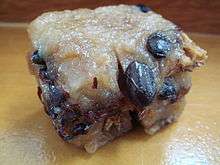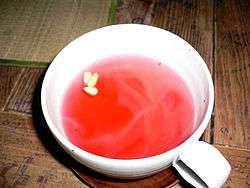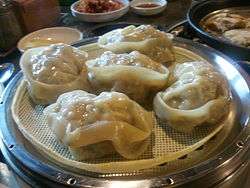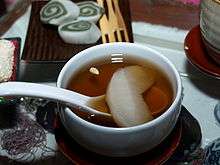List of Seoul dishes
This list is incomplete; you can help by expanding it.
This is a list of typical Seoul dishes found in Korean cuisine.
Main dishes
- Gukbap, soup with rice
- Heukimjajuk, black sesame porridge
- Jatjuk, pine nut porridge
- Memil mandu, dumpling with a buckwheat covering[1]
- Pyeonsu, square-shaped mandu (dumpling) with vegetable filling.[2]
- Saengchi mandu, dumpling stuffed with pheasant meat[3]
- Seolleongtang, beef soup with rice[4][5]
- Tteokguk, rice cake soup
Channyu; accompanied side dishes
- Amchi, dried salted brown croaker
- Eochae, parboiled fish fillet
- Gaksaek jeongol, casserole made with various ingredients[6]
- Galbijjim, braised meat short ribs
- Gannap, beef liver pancake[7]
- Gaphoe, seasoned raw beef tripe[8]
- Gimssam, wraps with gim, seaweed
- Gujeolpan, nine-sectioned plate
- Gulbi, dried salted yellow croaker
- Gulhoe, raw oyster
- Gwamegi, half-dried Pacific herring or Pacific saury
- Hobakseon, steamed stuffed zucchini
- Honghapcho, braised mussels in soy sauce
- Jang kimchi, water kimchi seasoned with soy sauce[9]
- Jangajji, pickles.
- Jeonbokcho, braised abalone
- Jeotgal, salted fermented seafood
- Jokpyeon, gelatin
- Maedeup jaban, fried kombu in a ribbon shape[10]
- Mitbanchan, basic side dishes made for preservation
- Mugeun namul bokkeum, sauteed dried various mountain vegetables
- Pyeonyuk[11]
- Useol pyeonyuk, pressed ox's tongue
- Yangjimeori pyeonyuk, pressed beef bricket
- Sinseollo, royal casserole
- Suk kkakdugi, kimchi made with parboiled daikon[12][13]
- Sukju namul, sauteed mung bean spouts
- Suran, poached egg
- Tteokbokki, stir-fried tteok, and vegetables
- Tteokjjim, boiled tteok, beef and vegetables[14]
- Yukgaejang, spicy beef soup with rice
- Yukpo, beef jerky
Tteok; rice cakes

Kongtteok, a variety of tteok made with black bean
See also: List of tteok varieties
- Tteokrice cakes
- Danja[15]
- Daechu danja, made with jujube
- Ssukgullae danja, made with Artemisia princeps var. orientalis
- Bam danja, made with chestnut
- Yuja danja, made with yuzu
- Eunghaeng danja, made with Gingko seeds
- Geonsi danja, made with gotgam (dried persimmon)
- Yulmu danja, made with Job's tears
- Seogi danja, made with seogi (Umbilicaria esculenta)
- Duteop tteok, covered with azuki bean crumbles[16]
- Gaksaekpyeon, made by adding color or flavors[17]
- Hwajeon, made with flower petals
- Juak, made by pan-frying and honey-glazing
- Mulhobak tteok, made with pumpkin
- Neuti tteok, made with young leaves of Zelkova serrata
- Sangchu tteok, made with lettuce[18]
- Solbangul tteok, made with pine cones
- Yaksik, made with nuts and jujubes
Hangwa; Korean confectionery
- Hangwa or Korean confectioneries
- Dasik, pattern pressed cake eaten when drinking tea.[19]
- Heukimja dasik, made with black sesame seeds
- Kong dasik, made with soybean
- Songhwa dasik, made with pine pollen powder
- Bam dasik, made with chestnut
- Jinmal dasik, made with a mixture of wheat flour and honey
- Nongmal dasik, made with starch
- Ssal dasik, made with rice
- Maejakgwa, oil-and-honey flour pastry
- Mandugwa, fried dumpling filled with sweeten jujube[20]
- Silkkae yeotgangjeong, covered with sesame seeds
- Ttangkong yeotgangjeong, covered with peanuts
- Baekjapyeon, covered with ground pine nuts
- Yakgwa, oil-and-honey pastry
- Yeotgangjeong, yeat mixed with roasted or raw grain.[21]
Eumcheongny; non-alcoholic beverages
Hwachae
- Hwachae, cold Korean punch made with fruits, edible flower petals, tteok, steamed grains, or traditional medical ingredients
- Bori sudan, barely punch
- Huintteok sudan, punch with garaetteok, cylindrical tteok
- Jindallae hwachae, punch with azalea petals
- Omija hwachae, Schisandra chinensis berry punch
- Wonsobyeong, punch with rice balls
Korean tea

A mug of omija cha, a Korean herbal tea made from the berries of Schisandra chinensis.
- Daechucha, made with jujube
- Dangguicha, made with Angelica
- Gokcha, made with grains
- Gugijacha, made with wolfberries
- Gyeolmyeongja cha, made with Senna obtusifolia
- Gyepicha, made with cinnamon
- Jehotang, made with various traditional medicine was considered the best summer drink at Korean royal court. The cold drink is made with honey, water and the powders of dried and roasted Prunus mume fruits, Amomi Semen, Sandalwood Red, and Amomum tsao-ko.
- Misamcha, made with Ginseng radicle
- Mogwacha, made with Chinese Quince
- Ogwacha, literally means "five fruits" is made with walnuts, chestnuts, Gingko seeds, jujube, and ginger.
- Omijacha, made with Schisandra chinensis berries
- Saenggangcha, made with ginger
- Yujacha, made with yuzu
See also
References
- ↑ 메밀만두 Doosan Encyclopedia
- ↑ 편수 片水
- ↑ 생치만두 生雉饅頭 Doosan Encyclopedia
- ↑ Seonnongdan Dongdaemun-gu
- ↑ 설렁탕 EncyKorea
- ↑ 각색전골 Doosan Encyclopedia
- ↑ 간전 Doosan Encyclopedia
- ↑ 갑회甲膾 Doosan Encyclopedia
- ↑ 장김치 醬─
- ↑ 매듭자반
- ↑ 편육 片肉 EncyKorea
- ↑ 숙깍두기 熟─
- ↑
- ↑ 떡찜
- ↑ 단자 團子
- ↑ 두텁떡 Nate Korean-English Dictionary
- ↑ 각색편 各色餠
- ↑ 상추떡 Nate Korean-English Dictionary
- ↑ Ttuk, Hangwa Food in Korea
- ↑ 만두과 饅頭菓
- ↑ 엿강정 Korea Food and Drug Administration
External links
- Official site of Korea National Tourism List of Korean Food
- Food in Korea at the Korea Agro-Fisheries Trade Corporation
This article is issued from Wikipedia - version of the 5/24/2016. The text is available under the Creative Commons Attribution/Share Alike but additional terms may apply for the media files.




